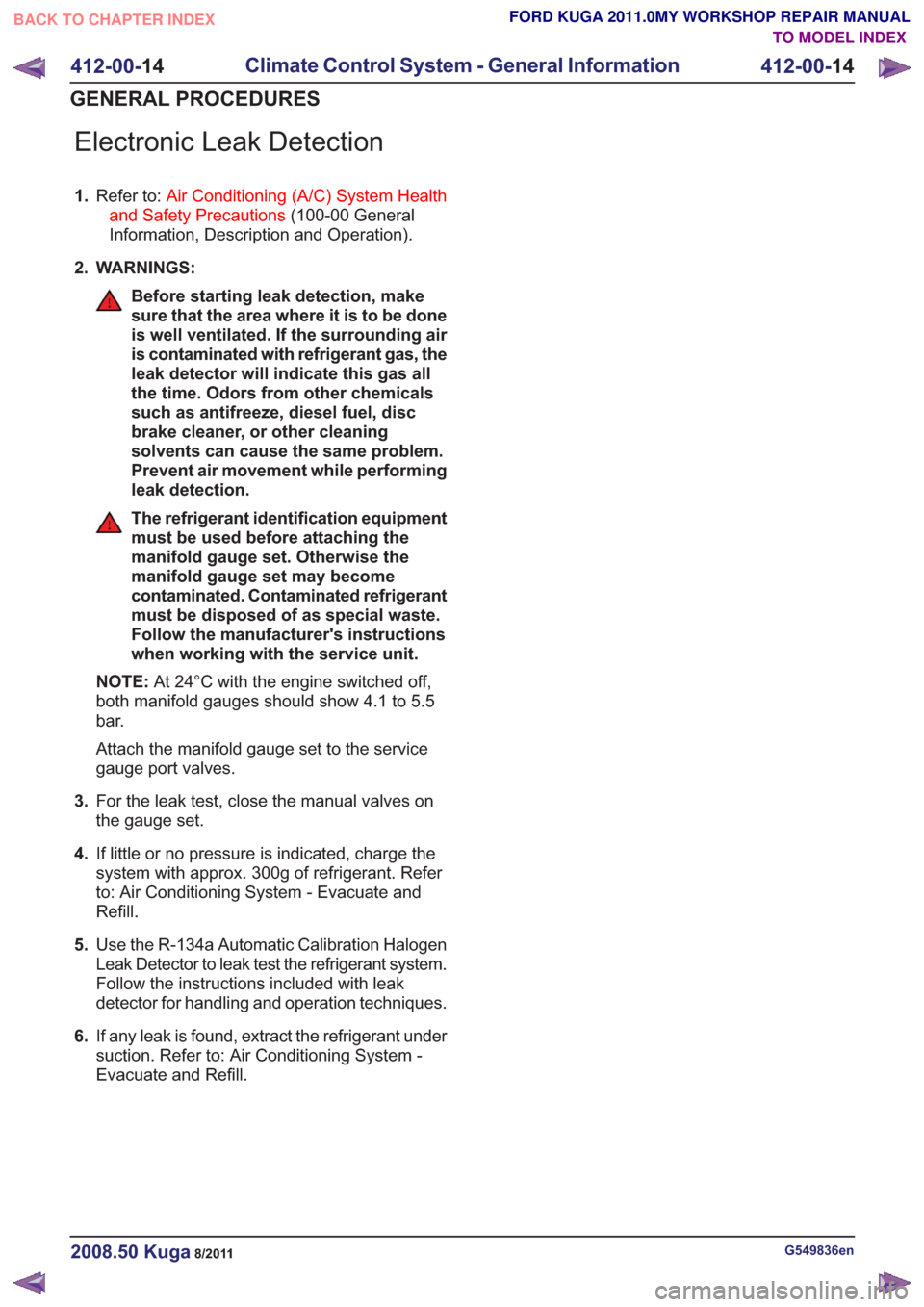Page 1994 of 2057
Fuel Filler Nozzle Inhibitor
Removal
WARNING: Avoid flames, sparks or lighted
substances.1.
Refer to: Petrol and Petrol-Ethanol Fuel
Systems Health and Safety Precautions
(100-00 General Information, Description and
Operation).
2.
E135960
3.
G1375941en2008.50 Kuga8/2011
310-01- 14
Fuel Tank and Lines
310-01- 14
REMOVAL AND INSTALLATION
TO MODEL INDEX
BACK TO CHAPTER INDEX
FORD KUGA 2011.0MY WORKSHOP REPAIR MANUAL
Page 1995 of 2057
E135961
4.Install the special tool(s) (supplied in the parts
kit).
G1375941en2008.50 Kuga8/2011
310-01- 15
Fuel Tank and Lines
310-01- 15
REMOVAL AND INSTALLATION
TO MODEL INDEX
BACK TO CHAPTER INDEX
FORD KUGA 2011.0MY WORKSHOP REPAIR MANUAL
Page 1996 of 2057
E135962
5.Turn until resistance is felt.
1.
E135963
12
G1375941en2008.50 Kuga8/2011
310-01- 16
Fuel Tank and Lines
310-01- 16
REMOVAL AND INSTALLATION
TO MODEL INDEX
BACK TO CHAPTER INDEX
FORD KUGA 2011.0MY WORKSHOP REPAIR MANUAL
Page 1997 of 2057
Installation
1. NOTE:Make sure that a new component is
1. installed.
2. Turn until resistance is felt.
E135964
12
G1375941en2008.50 Kuga8/2011
310-01- 17
Fuel Tank and Lines
310-01- 17
REMOVAL AND INSTALLATION
TO MODEL INDEX
BACK TO CHAPTER INDEX
FORD KUGA 2011.0MY WORKSHOP REPAIR MANUAL
Page 1998 of 2057
Fuel Pump and Sender Unit — 2.5L Duratec (147kW/200PS) -VI5
Special Tool(s) / General Equipment
310-210
Wrench, Fuel Tank Sender
Unit
E115757
Special Tool(s) / General Equipment310-211
Wrench, Fuel Tank Sender
Unit
E115758
Fluid Container
Removal
NOTE:Removal steps in this procedure may
contain installation details.
1. Refer to: Fuel Tank - 2.5L Duratec
(147kW/200PS) - VI5 (310-01 Fuel Tank and
Lines, Removal and Installation).
2. Special Tool(s): 310-211
Torque: 1
10Nm
310-211
x2
310-211
x2
E114253
3. CAUTION: Take extra care not to
damage the fuel tank level sensor float
and arm.
E112921
4.
E112922
Vehicles without fuel fired booster heater
5.Refer to: Quick Release Coupling (310-00 Fuel
System - General Information, General
Procedures).
E116270
G1000791en2008.50 Kuga8/2011
310-01- 18
Fuel Tank and Lines
310-01- 18
REMOVAL AND INSTALLATION
TO MODEL INDEX
BACK TO CHAPTER INDEX
FORD KUGA 2011.0MY WORKSHOP REPAIR MANUAL
Page 1999 of 2057
6.Special Tool(s): 310-210
Torque: 1
10Nm
310-210
x2
310-210
x2
E116489
Vehicles with fuel fired booster heater
7.Refer to: Quick Release Coupling (310-00 Fuel
System - General Information, General
Procedures).
E112978
8. CAUTION: Take extra care when handling the component terminals.
Special Tool(s): 310-210
Torque: 1
10Nm
310-210
x2
310-210
x2
E116490
1
All vehicles
9. CAUTION: Take extra care not todamage the fuel tank level sensor float
and arm.
E112979
10. WARNING: Be prepared to collectescaping fluid.
CAUTION: Use suitable paper to absorb
any escaping fluid.
Drain ther reservoir.
General Equipment: Fluid Container
E114482
Vehicles with fuel fired booster heater
NOTE: This step is only necessary when installing
a new component.
G1000791en2008.50 Kuga8/2011
310-01- 19
Fuel Tank and Lines
310-01- 19
REMOVAL AND INSTALLATION
TO MODEL INDEX
BACK TO CHAPTER INDEX
FORD KUGA 2011.0MY WORKSHOP REPAIR MANUAL
Page 2000 of 2057
11. CAUTION: If either component isdamaged, new paired components must
be installed.
E116518
Installation
1.To install, reverse the removal procedure.
Vehicles with fuel fired booster heater
NOTE: This step is only necessary when installing
a new component.
2. NOTE: Make sure that the component is clean
and free of foreign material.
Tighten the bolt until the head is sheared off.
E115615
NOTE: This step is only necessary when installing
a new component. 3.
E112980
G1000791en2008.50 Kuga8/2011
310-01-
20
Fuel Tank and Lines
310-01- 20
REMOVAL AND INSTALLATION
TO MODEL INDEX
BACK TO CHAPTER INDEX
FORD KUGA 2011.0MY WORKSHOP REPAIR MANUAL
Page 2025 of 2057

Electronic Leak Detection
1.Refer to: Air Conditioning (A/C) System Health
and Safety Precautions (100-00 General
Information, Description and Operation).
2. WARNINGS:
Before starting leak detection, make
sure that the area where it is to be done
is well ventilated. If the surrounding air
is contaminated with refrigerant gas, the
leak detector will indicate this gas all
the time. Odors from other chemicals
such as antifreeze, diesel fuel, disc
brake cleaner, or other cleaning
solvents can cause the same problem.
Prevent air movement while performing
leak detection.
The refrigerant identification equipment
must be used before attaching the
manifold gauge set. Otherwise the
manifold gauge set may become
contaminated. Contaminated refrigerant
must be disposed of as special waste.
Follow the manufacturer's instructions
when working with the service unit.
NOTE: At 24°C with the engine switched off,
both manifold gauges should show 4.1 to 5.5
bar.
Attach the manifold gauge set to the service
gauge port valves.
3. For the leak test, close the manual valves on
the gauge set.
4. If little or no pressure is indicated, charge the
system with approx. 300g of refrigerant. Refer
to: Air Conditioning System - Evacuate and
Refill.
5. Use the R-134a Automatic Calibration Halogen
Leak Detector to leak test the refrigerant system.
Follow the instructions included with leak
detector for handling and operation techniques.
6. If any leak is found, extract the refrigerant under
suction. Refer to: Air Conditioning System -
Evacuate and Refill.
G549836en2008.50 Kuga8/2011
412-00- 14
Climate Control System - General Information
412-00- 14
GENERAL PROCEDURES
TO MODEL INDEX
BACK TO CHAPTER INDEX
FORD KUGA 2011.0MY WORKSHOP REPAIR MANUAL